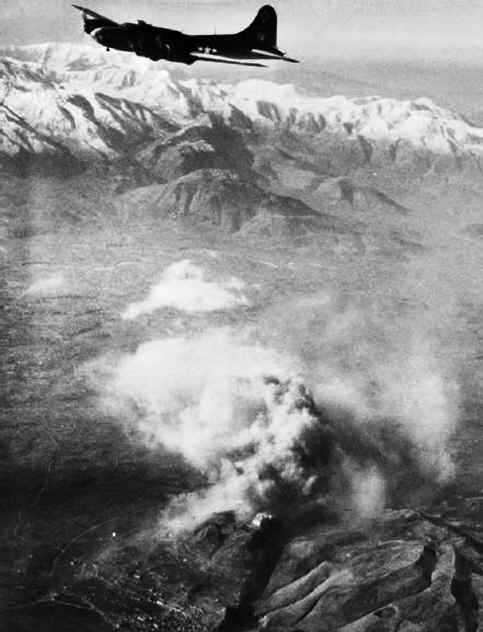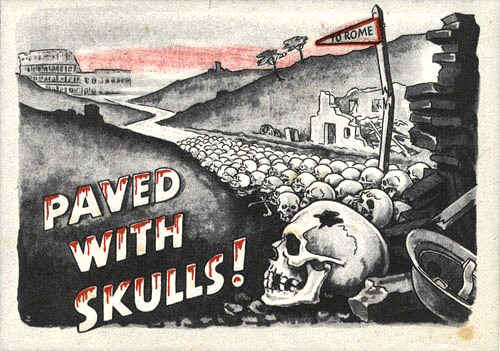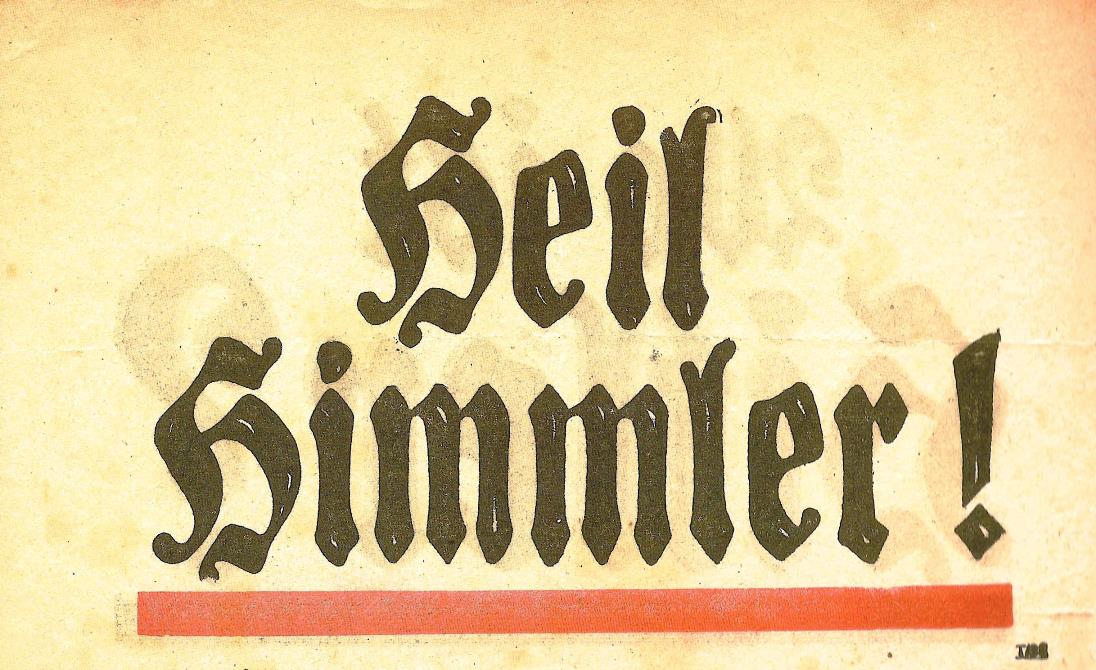As I mentioned above, this leaflet was what first enthused me about the study of the
battle for Monte Cassino. During WWII many Poles escaped the Great Britain where they
formed a Polish Free Corps. The Germans often targeted them in their propaganda, somehow
hoping the Poles would forget that they had bombed, invaded and occupied their country.
Why they believed any Pole might believe their message is beyond me. This leaflet depicts
a skeleton pointing toward the battlefront and telling the Poles to advance; while four
Poles are shown being blasted by German artillery. The language is Polish and translates
to:
POLES, you are going to CASSINO!
The message on the back is rather long and entitled Polish Soldiers! It tells
the soldiers that they were lucky that they were not in Poland when the Russians invaded
or they would have been killed in the Katyn forest massacre or imprisoned in the
“Soviet Paradise.” They do not mention that it was a deal between Hitler and
Stalin that allowed the Soviets to take half of Poland. The leaflet does tell the Poles
that if they come over to the Germans they will be immediately sent home and be free to
work at whatever job they want. I had looked high and low for a translation of this
leaflet with no luck. Then I found quite by accident that I had translated it back in 1968
and illustrated it in a British newspaper. Who remembers a short story written almost 50
years ago? The text says in part:
Polish Soldiers!
You are facing great danger. You have missed Katyn and you have escaped alive
from the Bolshevik paradise. You have been lucky so far – but now you are wanted no
more. United Polish troops are not admired by Stalin who is going to destroy your
Fatherland. Your leaders in London have received orders from Moscow to destroy you in the
least complicated way.
You have stayed till now in quiet positions in the central part of the Italian
Front. Now you are going to be thrown into Cassino Hell. Some years ago Stalin sent a
group of murderers to liquidate your colleagues at Katyn. The English are smarter. You are
going to die at Cassino as great heroes…
The Polish II Corps took parts in the attacks on Monte Cassino. The Poles lost 281
officers and 3,503 other ranks in assaults on the German 4th Parachute Regiment. On 12
May, the Polish infantry divisions were met with such devastating mortar, artillery and
small-arms fire that the leading battalions were all but wiped out. On 17 May, Polish II
Corps launched their second attack on Monte Cassino. Under constant artillery and mortar
fire the fighting was fierce and at times hand-to-hand. On 18 May a patrol of Polish 12th
cavalry Regiment finally made it to the heights and raised a Polish flag over the ruins.
Immediately after the cessation of fighting at Monte Cassino, the Polish government in
Exile (in London) created the Monte Cassino campaign cross to commemorate the Polish part
in the capture of the strategic point. During the Italian Campaign, the Polish II Corps
lost 11,379 men. Among them were 2,301 killed in action, 8,543 wounded in action and 535
missing in action.
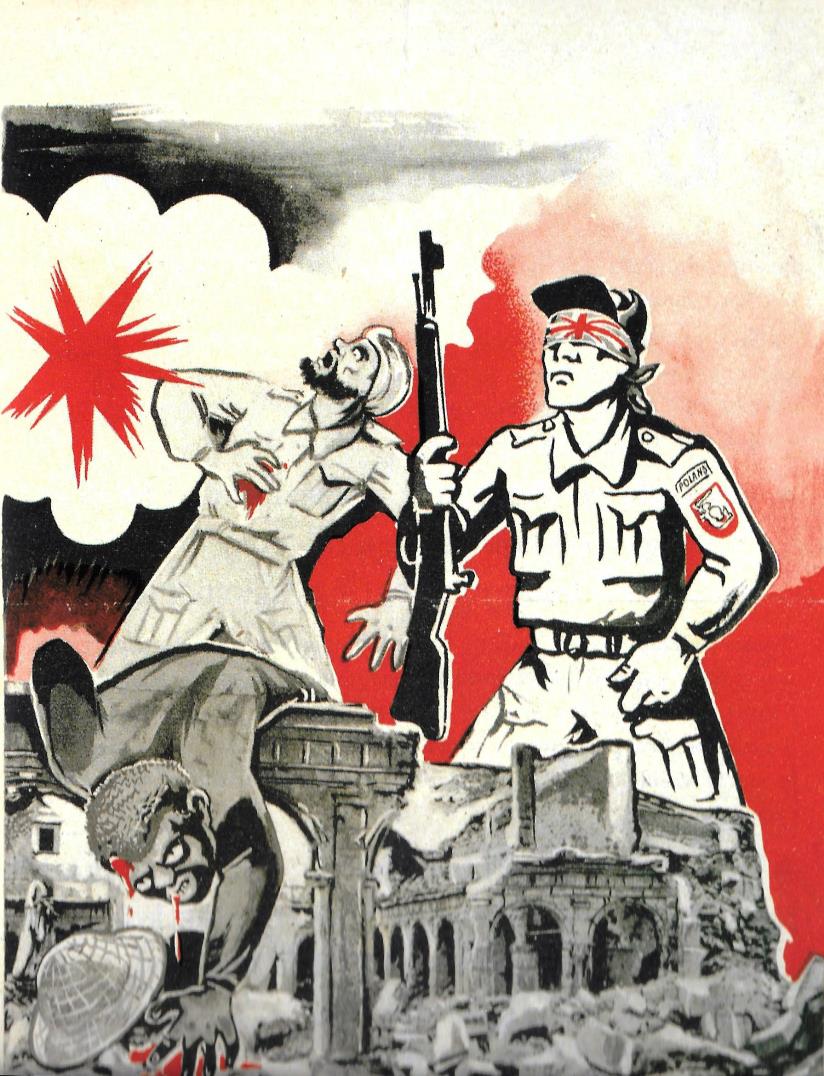
Go Home! – S.421
German leaflet S.421 targets Polish soldiers. We know that by the code “S”
which was always for Poles. I selected this leaflet because I think the artwork is really
interesting. We see a Polish soldier marching forward though blindfolded, presumably by
his British masters. At his left is a member of the Indian Division who has been injured
by an exploding shell fragment. On the ground with a head wound is a savage looking black
North African colonial soldier. The Germans often tried to drive a wedge between Allied
black and white soldiers pretending that they alone were socially conscious, but to their
own people and their Italian allies they mocked blacks and always pictured them as
uncultured savages. In the foreground we see the Monastery of Monte Cassino, wrecked by
Allied bombardment. The text reminds the Poles of how the British come begging when times
are hard. It ignores the fact that the Poles are with the British because the Germans
drove them there by an overwhelming sneak attack. The text says in part:
Polish soldiers! Have you thought about who you are fighting with jointly in Italy?
The English could always manage problems by themselves until the situation got serious.
When it became about their skin, they tried to get others to fight for them. Then they
brought in Americans, then Canadians, then French troops from General De Gaulle’s
camp, and Moroccans and Hindus. And finally it was the turn of you and the Hindus! And,
you were treated worse than the colored colonial army.
The Germans also broadcast radio messages to the Poles. The order to put a
Polish-language radio station on the air called Wanda was signed by Hitler in
February 1944. The station was broadcast from two rooms in the Italian State Broadcasting
Service in Rome. Wanda told the Polish soldiers that any soldier who defected to the
Germans would immediately be sent home. One program was taped and the announcer said to
the Polish troops at Cassino:
Your land has been delivered to Stalin’s hands by Churchill. You have no place
to return to when the war is done.
A great number of the German leaflets reminded the Poles to listen to Wanda, and many
also added the phrase Do Domu (Go Home), which they hoped the Poles would easily
remember and encourage them to defect. The radio propaganda leaflets were first written in
German, then translated to Polish. They were printed in Sulmona. Wanda made her last
broadcast on 23 April 1945.

Poster - M. Cassino – For your Freedom and Ours
Stanislaw Westwalewicz produced this propaganda poster for the Polish Public
Relations Unit in London in 1944. The text is in English and Italian. The Polish soldier
wears a British-type uniform with a Polish shoulder patch. He belongs to the II Polish
Corps equipped by the British army. Monte Cassino is at the top of the poster.
There were many more leaflets dropped on the Allied troops at Monte Cassino that do
not mention the monastery but were picked up off the ground. Many are mentioned in Peter
Batty’s 2005 book Paper War – Nazi Propaganda in one Battle, on a Single Day,
Cassino, Italy, May 11, 1944. Batty breaks up the leaflets he found that day into
several languages and targets. He says that the German thought he was with a British
division so mortared two English-language leaflets at his troops. The Polish division was
to his right and that confused the Germans and they then fired nine Polish leaflets at his
men. In fact, he was with the Indian division, and the Germans finally figured it out and
then mortared three Indian-language leaflets to his troops. We will illustrate two from
each group:
English Language:
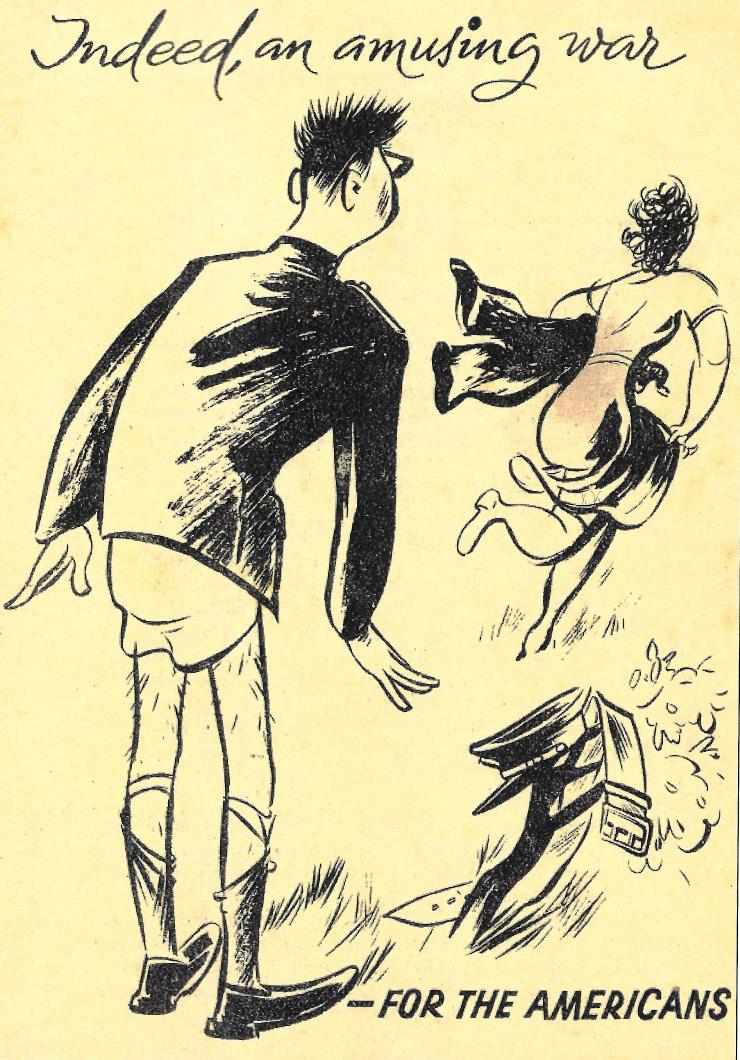
Indeed an Amusing war
A cartoon of a British woman fleeing with the pants of an American officer who thought
he would have sex with her.
The text is very long on
the back and says in part:
Before trying to breakthrough at Cassino, your command withdrew all American troops
from the main fighting line, because – as was stated by the B.B.C on 23.3.44, only
picked Allied troops could be used against the German parachutists…Is it worthwhile
thinking over why London has such a bad opinion about your American pals. Possibly because
70% of all Americans who came across are still hanging about in England?


Italy wants to see you
This is a very attractive leaflet in the form of a tourist guide. There is very little
text. The folded leaflet depicts a ghostly image of a girl on the beach and the scene of a
villa and trees and fruit. The text is:
Italy wants to see you
The back of the leaflet when unfolded shows a skull at the right over a field of
crosses and the text:
But did you expect to find it like this?
Polish language:

Polish friend – Do you want to die here?
Polish friend – do you want to die here? – This leaflet mentions
several Polish soldiers who have defected to the Germans. The code is S.414. Some of the
text on the back is:
Jan Lubszynski came to us on Easter Monday. Anxiety over Poland’s future and
his family’s happiness made him return home…In the next 14 days Jan Lubszynski
will find himself home. He’s asked us to send you his regards. Things are going well
for him and he’s in good spirit. He’ll tell you himself his opinions of the
Germans and how he has been treated. So listen to the “Wanda” broadcast to hear
your friend Jan Lubszynski

Polish Friends! Do you want to die for these?
Polish friends! Do you want to die for these? – An anti-Semitic and
pornographic leaflet depicting a naked woman on the lap of a caricatured Jew. The code is
S.415. Some of the text on the back is:
THE JEWS ARE GETTING THE BEST OF IT
You are wandering far from your close ones, in a far-away country. The swindlers and
imposers of the war are away from the front, enjoying every comfort, surrounded by their
families…Would you like to know how your nearest and dearest are, what they think of
the war, and how they are yearning for you? If you do, come to us. We assure you an
instant return to your Fatherland. Your wives, children and beloved Fatherland await you!
SLOGAN: GO HOME!

Leaflet XP-2
I add this
leaflet because it mentions Monte Cassino. On the front of this British
(PWE) and American (OWI) leaflet we see the British, Polish and American
flags. The code "X" shows it was for civilians, and the "P" mean "Polish."
The text is:
POLES!
The Allied Air
Forces of the West are now operating in the skies of Poland. We who bring
you this message are flying on to bases in Russia. We will return to attack
the German war machine wherever it may hide.
The flag of
Poland floated over Monte Cassino, where the heroic soldiers of Poland gave
their lives to win the victory which helped to save Rome from German
destruction.
The flag of
Poland is carried triumphantly in the pursuit of the retreating German
armies through Italy.
Great Allied
forces have attacked the European fortress from land, sea and air. The
Polish Air Force took part in this attack and shot down a record number of
German airplanes.
In this hour,
when Polish arms are winning glory on the field of battle, the United
Nations are mindful also of the other unceasing battle which for four years
you have been courageously waging on the soil of Poland,
Today, we of
the Allied Air Forces come to help the Polish Underground Army in the
destruction of the hated German oppressor.
By bombing from
the air, we are helping you who fight on the ground. We are both attacking
the same targets, German armed forces, transport, factories, and stores of
war material.
Despite the
care we shall take to avoid civilian suffering, there will be casualties
from our air attacks. By taking precautions you can help to reduce these
casualties.
Save your
families and yourselves by getting away from military targets.
Take shelter
whenever the alarm is given.
LIVE FOR POLAND.
We of the
Allied Air Forces now operating over Poland from bases in Britain, Italy and
Russia, fight under the slogan which Poland was first to carry on her
banners:
FOR YOUR FREEDOM AND FOR OURS.
Indian languages:
Some of the recruiting of Indian troops is mentioned by Gurbachan
Singh Mangat in Indian National Army, Gagan Publishers, New Delhi,
1991. He says that a party of 27 men under command of a Lieutenant
Jamil Ahmed Khan was sent to Italy to interview Indian POWs captured by the
Axis. The group also produced loudspeaker messages and propaganda leaflets
to drop over Indian troops fighting with the British forces. Leaflets were
also fired to the Indian troops by mortar and rocket (propagandawerfer).
In 2009, author Martin Bamber sent me a letter asking permission to
use some of the Indian leaflet images and sending some further data on Jamil
Ahmad Khan:
The rocket used was most likely the 7.3-centimeter PgGr41 rocket
that could carry .5 kilogram of paper leaflets. Another squad led by
Feldwebel Banta Singh used the 8.1-centimeter rocket. One of these leaflets
was later recovered by an Italian farmer in the town of Faenza, near where
the British 8th Indian Division operated in early 1945. On one side it
pictured Indian soldiers (quoting their names, ranks, service numbers and
former Indian Army units) receiving exemplary hospital care. The back had a
Hindustani propaganda message:
MY INDIAN FRIENDS
What do you think? Do
you still believe the English Propaganda that Germans kill their prisoners?
LOOK!
Overleaf are
photographs of some of your comrades who were wounded in battle. They have
been sent to a hospital and are receiving excellent care.
GERMANS ARE HUMAN
And they know how to act in a humane way.
AND
Prisoners of war can
spend their time in camps in comfort and will return home after the war is
ended.
WAIT!
For the second
edition where we will publish photographs of your friends who have been
captured recently.
Lieutenant Jamil Ahmed Khan
also operated in then Monte cassino sector where the British 4th Indian
Infantry Division was engaged. A radio propaganda station named “BHAIBAND”
(“Comrade”) was also set up in Rome. Two 30-minute transmissions were made
each day. It was reported that Indian prisoners-of-war and defectors had
both heard the radio programs and read the propaganda leaflets, but the
results were meagre. The British Indian soldiers had not even been forbidden
to listen to Radio Station Bhaiband, which gives some indication as to how
seriously the British military authorities looked upon the effects of Indian
nationalist propaganda upon their own Indian troops.

One mouse is the head of an elephant
One mouse is the head of an elephant – A story of how a mouse
(England) rules India (the elephant). The text is:
A mouse is the leader of the
Elephant
Once upon a time when an elephant was sleeping, a mouse came up to him and saw him
sleeping so soundly that he tied the elephant with a chain. Even since the elephant has
remained a slave of the mouse. One day a cat
came by and wanted to eat the mouse. The mouse ran to the elephant and asked for help. He
promised the elephant that if he helped the mouse would set him free. The innocent
elephant helped the mouse against the cat and then asked him to release the chains. The
mouse laughed at the elephant and replied, “You don’t deserve to be set free;
you are not fit for it.” After a few days the same cat came again and attacked the
mouse. The mouse once again went to the elephant for help.
The elephant replied, “You are dishonest; a traitor and deceiver! I won’t
help you. I’ll try to break my chains by myself. It is good for the cat to eat
you.” And that is exactly what happened, the cat ate the mouse and the elephant
applied a bit of strength to break his own chains and was free.
This is your state! A big country like India is a slave to a small country like Britain.
The Indian soldiers should be fighting for their freedom which can only be achieved if England
is destroyed. You are only fighting to remain enslaved.

Boycott foreign goods
This leaflet depicts Mahatma Gandhi and the trials the British put him through. The
code number is  163/914,
which indicates that it was printed by the Propaganda-Einsatz Fuehrer organization.
Text on the front is:
163/914,
which indicates that it was printed by the Propaganda-Einsatz Fuehrer organization.
Text on the front is:
Boycott foreign goods
The text on the back is in part:
The Mahatma’s life is full of sorrow, with many problems and
sacrifices.
His thousands of companions also had to face the hardships of being a political
prisoner. This is all for love of their country! They are doing all this for their
country, for their Indian brothers, for you.
Yes for you! And your children too!
They should not have to join the army to fulfill their hunger and earn a living, and
they shouldn’t have to give up their life for free for another country and race. Like
you! And if you lose your life for this army all of the sacrifices of Mahatmas will go to
waste.
This ends our look at German propaganda. There were dozens of different leaflets
fired at the Allies by artillery and mortar and we have depicted just a few of them.
Perhaps in the future we will add more leaflets to this article if we find any
particularly interesting ones.
The German Explanation and Postcard Blitz

German Postcard 184 - The Abbey Destroyed
Immediately after the destruction of the abbey, the Germans did a propaganda blitz
where they produced a set of 10 propaganda postcards coded 184 to 193, showing Monte
Cassino before and after the bombing. The cards were issued at the end of February 1944.
They were offered in an envelope coded PAJ 1/94. “PAI” is equivalent to
“PAJ”, and stands for Propaganda Abteilung Italien Gruppe Kampfpropaganda
– the War Propaganda Group of the Italian Propaganda Department of the German Abwehr.
The Abwehr was the intelligence unit for the German Oberkommando der Wehrmacht
(OKW). The cards were coded and entitled:
Code 184. The abbey destroyed.
Code 185. Picture of the main altar.
Code 186. A courtyard in the abbey.
Code 187. The abbey.
Code 188. Smoking ruins of the abbey.
Code 189. The destroyed abbey.
Code 190. A courtyard within the abbey.
Code 191. The abbey library
Code 192. The abbey’s sacristy.
Code 193. The declaration released by the abbot after the destruction, attesting in
Italian and German that there had never been any German soldiers in the monastery. The
statement by the Bishop of the abbey written in German and Italian said:
This is the statement given out by the Abbot of Monte Cassino after the destruction
of the monastery by Anglo-American aircraft of 15 February 1944.
15 February 1944
I testify that the whole truth is that German soldiers have never been within the
precincts of the holy monastery of Cassino. For a certain time there were three police
with the task of carrying out an inspection of the neutral zone which was established
around the monastery, but they were withdrawn 20 days ago. Of my own free will I state
that there are not now, and never have been any German soldiers in the Monastery of Monte
Cassino.
Gregorio Diamare
Bishop and Abbot

VI Corps G2 (Intelligence) German Propaganda Leaflet Souvenir Booklet
Before we leave all the German leaflets used against U.S. forces
during the Italian campaign from 2 January to 6 June 1944 when the Allies
invaded mainland Europe. I want to show you a booklet that was prepared by
the VI Corps and issued to some troops as a souvenir of the campaign. This
51-page booklet depicts many of the leaflets dropped from aircraft and fired
by artillery, mortar, and rocket by the Germans. I would not have added it,
except on the cover we do see “The Cassino Debacle,” and that qualifies this
booklet as a Monte Cassino item. The booklet points out:
The leaflets that follow are only a sampling of the total
encountered, but they serve to illustrate the many different themes used by
the Germans. Many are an attempt to split the Allies, while others attempt
to destroy the soldier’s faith in the home front, his Commander-in-Chief,
his girl, his friends, and his country. Much of the propaganda is
antisemitic which was a favorite Nazi theme, while a good deal of it
appealed directly to the soldier in telling him that “Death awaited him as
long as he continued to fight.”
In addition to the small pamphlets, a bi-monthly paper, dubbed “The
Lightning News,” was used by the Germans. Also, there were daily broadcasts
by “Sally” over Jerry’s radio station and the frequent use of front-line
loudspeakers. But whatever the method, and regardless of the words used, the
idea behind the entire program was to make the soldier soft, unhappy, lose
the desire to fight, and desert.
Allied Leaflets
We don’t know much about Allied propaganda leaflets prepared for Monte Cassino.
It seems likely that most that were fired to the top of the mountain were destroyed, burnt
for heat or used as toilet paper. We do know that the above leaflet was part of a
propaganda campaign to try and convince the Germans that Himmler was taking power from
Hitler. It was found on the ground at the base of the mountain. There were variations of
this theme in several black operations. We believe this leaflet was prepared by the
Psychological Warfare Branch of the Allied Forces Headquarters, 8th Army (UK). The AFHQ
controlled all Allied operational forces in the Mediterranean Theatre of World War II from
late 1942 until the end of the war in Europe in May 1945.
Soldiers of Cassino - 8-23
Researcher Lee Richards found two Cassino leaflets in the British National Archives,
reference WO 204/6444. Both are from PWB/AFHQ 8th Army and addressed to Soldiers of
Cassino. Both have a safe conduct pass on the back. The text of 8-23 is:

SOLDIERS OF CASSINO!
The game is over! CASSINO is lost for Germany. Look to the Abbey - there you can see
the Poles! Look around you: Our troops are approaching from your left and right. You
fought bravely. Fighting is futile! You are encircled on all sides - if you do not believe
this, send out observers! Nobody forces you to fight until the end. Each of you has the
choice:
EITHER - lay down your weapons now! OR - wait until we come; we and the Poles, whose
land you attacked in 1939.
GIVE IT UP!
Prisoners of War are treated as soldiers.

Soldiers of Cassino - 8-25
This leaflet is very similar to 8-23 except the message is a good deal shorter. The
text is:
SOLDIERS OF CASSINO!
THERE IS NO MORE TALKING!
If you want to be taken prisoner come down Via Casilina, through
CASSINO.
Hands Up! Without weapons!
Wave something white over your head!
Prisoners of War are treated decently!
An Allied Propaganda Newspaper
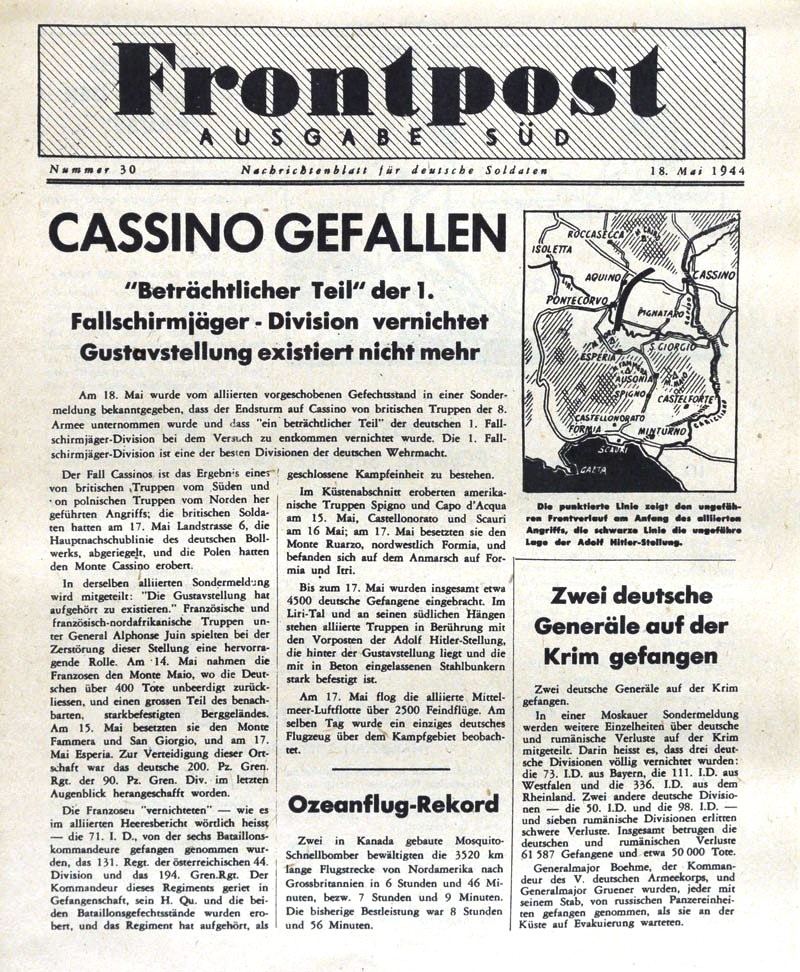
Frontpost South
This Allied newspaper is not propaganda that was used during the battle. It is the U.S.
5th Army Psychological Warfare Branch newspaper Frontpost South announcing the fall
of Cassino. It was meant to tell the German military and civilians of another defeat and
attack their morale. It is dated 18 May 1943 and shows a map of the battlefield at the
upper right. Some of the Cassino-oriented article is:
Cassino Falls
A substantial part of the 1st Parachute Division no longer exists.
On May 18th a special communique from Allied Advanced Headquarters announced that
the final assault on Cassino had been carried out by British troops of the 8th Army and a
substantial part of the German 1st Parachute Division had been destroyed in efforts to
escape. The division is one of the best in the German Army.
The same Allied special communique reported: The Gustav Line has ceased to
exist…Up to May 17th about 4,500 Germans were taken prisoner in all sectors…On
May 17th the Mediterranean Air Force flew over 2,500 sorties. During the same day, one
German aircraft was observed over the battle area.

Allies warn Italian Civilians to Abandon Monte Cassino
US soldiers of the Allied Fifth Army load 155mm shells with leaflets urging Italian
civilians to abandon Monte Cassino monastery because Germans were using the ancient abbey
in Western Italy as an artillery and observation post. The pamphlets were fired into the
monastery area by artillery before the Allies bombed Mount Cassino to dislodge the German
forces.

The Germans drop
leaflets on the Monastery.
Sometime after the end of the war a series of short news films
called Battle Line were produced to tell Americans the history of
WWII. One of the battles depicted in the series was Monte Cassino. It told
about the Allied push up the Italian boot and ended with the bombing of the
monastery.
The narrator tells us that on 14 February, leaflets were dropped on the
abbot, five monks, and the refugees living in the monastery, warning that
Monte Cassino will soon be bombed. No date is given for the leaflet drop.
We are told that the 80-year-old abbot requested that German
escorts be provided to lead them all to safety. He is assured by the Germans
that they will have an escort within two days. On 15 February, just one day
later, the brothers and refugees are still in the monastery when an ominous
sound turns the German eyes toward the sky. It
is American bombers.
We were told that no German troops were inside the monastery, but
it was believed that they might go behind the 12-foot walls once the allies
start advancing up the mountain. It was stated that everyone believed the
monastery must be destroyed, even the local Italians. The makers of the film
probably believed they must find a way to justify the bombing. After the
explanation, the film depicts a squadron of B-17 Flying Fortress bombers
destroying the monastery. Later the film
shows 500 B-17s also bombing the occupied town of Monte Cassino.
After the battle, the German commander of the airborne defenders,
Major Rudolf Bamber, said that:
Now that the monastery was turned into rubble, I decided to move my
headquarters inside the area that was once the monastery.
If his story is accurate, it implies that the bombing of the
monastery benefited the Germans and gave them a wonderful defensive position
to pour fire down on the allied forces.
The Germans fight on and on 11 May, three months later, the final
assault begins which leads to an Allied victory. The fate of the German
airborne defenders? They simply retreated five miles to another defensive
line to continue the battle.

25 Years after the Battle, the Poles
Commemorate
Monte Cassino with a Postage Stamp
This ends our short look at the propaganda used in the battle for Monte Cassino. The
article could easily be three or four times larger if we added all the leaflets we are
aware of, but this is just meant to whet the appetite of the reader. It is a wonderful
subject for further research. Any readers that care to comment on this article are
encouraged to write to the author at Sgmbert@hotmail.com.


